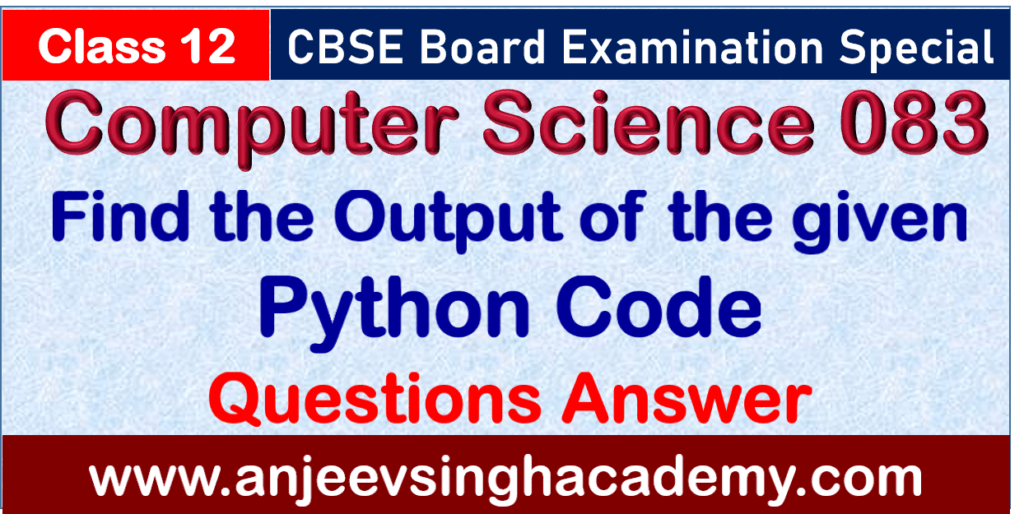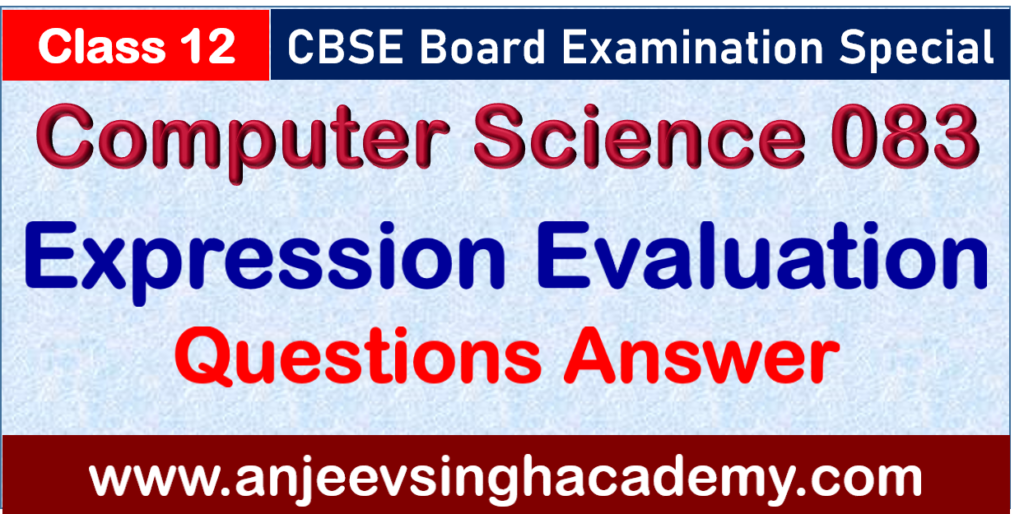Hello Dear Students
In this post, I am sharing important python error finding and correcting questions with valid reasons. These questions help you in understanding python concepts.
All the best.
Q 1: Rewrite it after removing all syntactical errors with each correction underlined.
| DEF execmain(): x = input(“Enter a number:”) if (abs(x)= x): print”You entered a positive number” else: x=*-1 print”Number made positive:”x execmain() |
| Answer: def execmain(): x = input(“Enter a number:”) if (abs(x) = = x): print(“You entered a positive number“) else: x *= -1 print (“Number made positive:“, x) execmain() |
| Reason:- def => must be in small letter = = => use for comparison () => in the print argument must be enclosed in () *= => first arithmetic then assignment , => in print() values are separated by , (comma) |
Q 2: Rewrite it after removing all syntactical errors with each correction underlined.
| STRING=””HAPPY NEW YEAR” for S in range[0,8]: print STRING(S) print S+STRING |
| Answer: STRING = “HAPPY NEW YEAR“ for S in range(0,len(STRING)): print(STRING[S]) print (S, STRING) |
| Reason:- •Only one double quote is required in beginning. •In range() , curved bracket is required •Use len(STRING) instead of value. •print need () and to access the member need to use [] |
Q 3: Rewrite it after removing all syntactical errors with each correction underlined.
| def checkval: x = input(“Enter a number”) if x % 2 = 0: print x,”is even” else if x<0: print x,”should be positive” else; print x,”is odd” |
| Answer: def checkval(): x = int(input(“Enter a number:”)) if x % 2 == 0: print(x, “is even”) elif x<0: print(x, ”should be positive”) else: print(x, ”is odd”) |
| Reason:- •Function header must contain () •int( ) to convert string to integer, because input returns string value •= = is use for comparision •elif is use to check condition with else •Use ( ) with print to display values |
Q 4: Rewrite it after removing all syntactical errors with each correction underlined.
| 25=Val for I in the range(0,Val) if I%2=0: print( I+1) Else: print (I-1) |
| Answer: Val = 25 for I in range(0,Val): if I%2 == 0: print( I+1) else: print (I-1) |
| Reason:- •Variable must be left to assignment •the is not a valid keyword in for. •: is required at the end of for statement •= = is use for comparison •else is a keyword, used in small letter |
Q 5: Rewrite it after removing all syntactical errors with each correction underlined.
| Num = int(rawinput(“Number:”)) Sum = 0 for i in range(10,Num,3) Sum+=i if i%2=0: print ( i*2) Else: print ( i*3 print Sum) |
| Answer: Num = int(input(“Number:”)) Sum = 0 for i in range(10,Num,3) : Sum += i if I % 2 == 0: print ( i*2) else: print ( i*3) print (Sum) |
| Reason:- • rawinput() not available in python • : is required at the end of for statement • Sum+=i will be after for. • = = is use for comparison • else is a keyword, used in small letter • print(Sum) should be outside the loop |
Q 6: Rewrite it after removing all syntactical errors with each correction underlined.
| a = int(input(“Value:”)) b = 0 for c in range(1,a,2) b + = c if c%2 = 0: Print (c*3) Else: print (c*) print (b) |
| Answer: a = int(input(“Value:”)) b = 0 for c in range(1,a,2) : b + = c if c%2 == 0: print (c*3) else: print (c*2) print (b) |
| Reason:- • : is required at the end of for statement • Indentation is required in all statement after for • = = is use for comparison • else is a keyword, used in small letter • Print(b) should be outside the loop |
Q 7: Rewrite it after removing all syntactical errors with each correction underlined.
| def main(): r = input(‘enter any radius: ‘) a = pi * math.pow(r,2) print(“Area = “ + a) |
| Answer: import math def main(): r = int(input(‘enter any radius:’) ) a = math.pi *math.pow(r,2) print(“Area = ” , a) |
| Reason:- • Import math module to use mathematical function • Convert string to integer • Use math.pi instead of pi • Use comma (,) to separate multiple value in print() |
Q 8: Rewrite it after removing all syntactical errors with each correction underlined.
| Def checkNumber(N): status = N%2 return #main-code num=int( input(” Enter a number to check :)) k=checkNumber(num) if k = 0: print(“This is EVEN number”) else: print(“This is ODD number”) |
| Answer: def checkNumber(N): status = N%2 return status #main-code num = int(input(” Enter a number to check : “)) k = checkNumber(num) if k == 0: print(“This is EVEN number”) else: print(“This is ODD number”) |
| Reason:- · def must be in small letter · Function should return a value of status · String must be enclosed in double quotes. · == is use for comparison. |
Q 9: Rewrite it after removing all syntactical errors with each correction underlined.
| define reverse(num): rev = 0 While num > 0: rem == num %10 rev = rev*10 + rem num = num//10 return rev print(reverse(1234)) |
| Answer: def reverse(num): rev = 0 while num > 0: rem = num %10 rev = rev*10 + rem num = num//10 return rev print(reverse(1234)) |
| Reason:- · def is use to define a function · while is a keyword, written in small letter · = is use for assignment, while == is use for comparison · return rev must be indented |
Q 10: Rewrite it after removing all syntactical errors with each correction underlined.
| def sum(arg1, arg2): total = arg1 + arg2; print(”Total:”, total) return total; sum(10,20) print(”Total:”,total) |
| Answer: def sum(arg1, arg2): total = arg1 + arg2; print(”Total:”,total) return total; total = sum(10, 20) print(”Total:”, total) |
| Reason:- · def is use to define a function · while is a keyword, written in small letter · = is use for assignment, while == is use for comparison · return rev must be indented |
Q 11: Rewrite the following code in Python after removing all syntax error(s). Underline each correction done in the code.
| Runs = ( 10, 5, 0, 2, 4, 3 ) for I in Runs: if I=0: print(Maiden Over) else print(Not Maiden) |
| Answer: Runs = ( 10, 5, 0, 2, 4, 3 ) for I in Runs: if I == 0: print(“Maiden Over”) else: print(“Not Maiden”) |
| Reason:- * = is use for assignment, while == is use for comparison * use ” ” to print message. * use : after else |
Q 12: Rewrite the following code in Python after removing all syntax error(s). Underline each correction done in the code.
| input(‘Enter a word’,W) if W = ‘Hello’ print(‘Ok’) else: print(‘Not Ok’) |
| Answer: W = input(‘Enter a word’) if W == ‘Hello’ : print(‘Ok’) else: print(‘Not Ok’) |
| Reason:- * input() function return a string value, which need to assign to a variable. * = is use for assignment, while == is use for comparison * use : at the end of if header * de-indent the else: |
Q 13: Rewrite the following code in Python after removing all syntax error(s). Underline each correction done in the code.
| 250 = Number WHILE Number<=1000: if Number=>750: print Number Number=Number+100 else print Number*2 Number=Number+50 |
| Answer: Number = 250 while Number <= 1000: if Number >= 750: print (Number) Number = Number + 100 else: print (Number*2) Number = Number + 50 |
| Reason:- * Variable must be before assignment operator * while should be in small letter, it is a keyword * use >= * use : at the end of else header |
Q 14: Rewrite the following code in Python after removing all syntax error(s). Underline each correction done in the code.
| “HELLO”=String for I in range(0,len(String)–1) if String[I] => “M”: print(String[I], “*” Else: print(String[I-1]) |
| Answer: String = “HELLO” for I in range(0, len(String)–1) : if String[I] >= “M”: print(String[I], “*”) else: print(String[I-1]) |
| Reason:- * Variable must be before assignment operator * use : at the end of for header * use >= instead of => * use ) at the end of print statement * use else instead of Else |
Q 15: Rewrite the following code in Python after removing all syntax error(s). Underline each correction done in the code.
| Val = int(input(“Value:”)) Adder = 0 for C in range(1,Val,3) Adder += C if C%2 = 0: Print C*10 Else: print(C) print(Adder) |
| Answer: Val = int(input(“Value:”)) Adder = 0 for C in range(1,Val,3) : Adder += C if C%2 == 0: print(C*10) else: print(C) print(Adder) |
| Reason:- * use : at the end of for loop header * use == instead of = for comparison * use print( ) instead of Print( ) * use else instead of Else |
Q 16: Rewrite the following code in Python after removing all syntax error(s). Underline each correction done in the code. [CBSE 2018 COMPARTMENT]
| Num = int(input(“Number:”)) Sum = 0 for i in range(10, Num, 3) Sum += i if i%2 = 0: print( i * 2 ) Else: print(i * 3) print Sum |
| Answer: Num = int(input(“Number:”)) Sum = 0 for i in range(10, Num, 3) : Sum += i if i%2 == 0: print( i * 2 ) else: print(i * 3) print(Sum) |
| Reason:- * use : at the end of for loop header * use == instead of = for comparison * use else instead of Else * use print(Sum) instead of print Sum |
Q 17: Rewrite the following code in Python after removing all syntax error(s). Underline each correction done in the code. [CBSE 2017 ]
| STRING = “”WELCOME NOTE “” for S in range[0,8]: print(STRING(S) ) print(S+STRING) |
| Answer: STRING = “WELCOME” NOTE = “” for S in range(0, 8): print(STRING(S) ) print(S , STRING) |
| Reason:- * String value must be enclosed in ” “ * use = to assign a empty string to NOTE * use ( ) with range function. * use [ ] to access the element of string i.e. STRING[S] * Integer can not be concatenated with string. So use the, (comma) in place of + |
Q 18: Rewrite the following code in Python after removing all syntax error(s). Underline each correction done in the code. [CBSE 2016]
| for Name in [Ramesh, Suraj, Priya ] IF Name[0] = ‘S’ : print(Name) |
| Answer: for Name in [“Ramesh”, “Suraj”, “Priya” ] : if Name[0] == ‘S’ : print(Name) |
| Reason:- * String value must be enclosed in ” “ * if must be small letter. It is a keyword. * use == to compare |
Q 19: Rewrite the following code in Python after removing all syntax error(s). Underline each correction done in the code. [CBSE 2015]
| def Tot(Number) : #Method to find Total Sum=0 for C in Range (1, Number+1): Sum += C RETURN Sum print Tot[3] #Function Calls print (Tot[6]) |
| Answer: def Tot(Number) : #Method to find Total Sum = 0 for C in range (1, Number+1): Sum += C return Sum print (Tot[3]) #Function Calls print (Tot[6]) |
| Reason:- * range() must be in small letter * return must be in small letter * use () with print function |
More questions will be uploaded soon.







